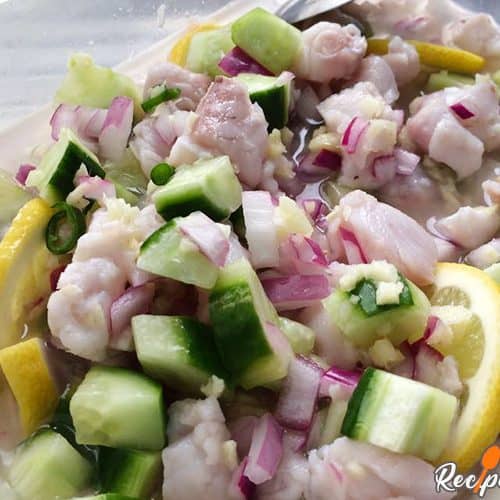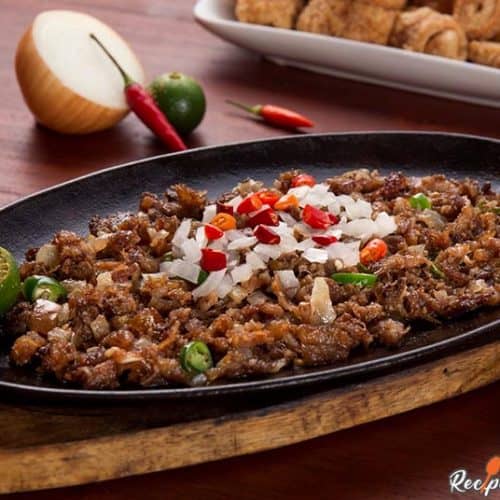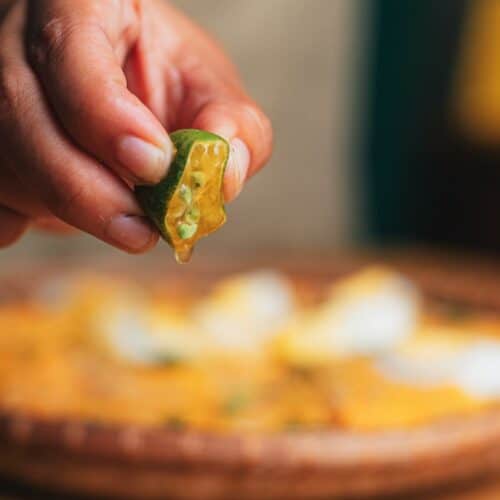11 Best Recipes With Calamansi
Do you have some calamansi but don’t know what to do with it?
Calamansi has a distinct sour and tangy taste and is used to add flavor to many dishes. Some dishes just use it to give it a little sourness, but I have a few recipes I’ll share with you where it really stands out so you can make the best use of its flavor.
If you’re looking for some delicious recipes that use calamansi, look no further. I’ve gathered some of the best ones so you can try them out at home.


Check out our new cookbook
Bitemybun's family recipes with complete meal planner and recipe guide.
Try it out for free with Kindle Unlimited:
Read for freeIn this post we'll cover:
Top 11 recipes with calamansi
Bangus sisig

Sisig is definitely one of Pinoy’s favorite dish or mostly eaten as “Pulutan” for drinking sprees and different kind of occasions.
We have a lot of Sisig varieties and the most common of it is the sizzling “Pork Sisig” but some of us tried to avoid eating this type of sisig as much as possible because the primary ingredient is pork which is high in cholesterol.
Fortunately, we can still enjoy our sisig without so much fat-like substance by using Bangus. This Bangus Sisig recipe is easy to cook and very scrumptious to eat.
Pata hamonado

In many Filipino celebrations, especially in the provinces, it is not unusual to see poultry and cattle being slaughtered for its meat.
And being the unwasteful Filipinos that we are, we make sure that we can make use of all of the parts of the animal for food.
And by everything, we mean everything from head to foot.
Bistek tagalog

It uses Four simple ingredients— pork or beef, onion rings, calamansi juice, and soy sauce.
The sourness of the calamansi juice and the saltiness of the soy sauce just make the perfect blend of flavors for bistek.
The slices of meat are pounded using a pork mallet or the back of a knife.
The pounding helps in tenderizing the pork or beef slices and also aids in the absorption of flavor and helps in cooking the meat faster.
One of the key elements of this dish is the onion ring slices. Large white onions are used and not the red shallots.
Camaron rebosado

Though at first look, you would think that we got our inspiration for this Camaron Rebosado recipe from the Japanese, a possible inspiration for this dish is actually the Gambas Rebozadas of the Spanish.
However, the latter uses saffron powder instead of the flour that we use for our Camaron Rebosado.
We also assimilated the dish in that we marinade first the shrimp with Filipino lemon or lemon before frying.
As for the dip, being influenced by the Chinese, it is recommended that one uses the sweet and sour dip although mayonnaise with heaps of chopped garlic, soy sauce with chopped onions, or ketchup can also be served as dips.
Filipino marinated pork barbecue

Pork Barbecue is also a staple among street food vendors. You would normally see every street and corner selling barbecued foods in all forms and sizes.
The secret in achieving the moist and tender pork Barbecue is to marinate the pork slices into the marinade mixture with calamansi for at least 12 hours or overnight inside the chiller.
Kinilaw na isda

Preparing this Filipino food is so easy that even a child can do it. One of the secrets to preparing this dish lies in having the freshest fish cut into cubes.
But do you know who’s the best person to prepare this type of dish? Well, it’s not the chefs in fine restaurants or even locals; it’s the Filipino dads who are about to get drunk on any special occasion!
This kinilaw na isda recipe is really special. Some people even call kinilaw “the Philippine’s answer to Japan’s sushi”. As I said, this cooking doesn’t involve cooking over a fire.
Instead, it’s the vinegar that’ll “cook” the fish meat by soaking for over 10 minutes. The acid content of the vinegar will make fish meat nontransparent, giving it the look and texture of cooked fish.
Filipino beef mechado

The oiliness of the beef, the sweetness, and sourness of the tomato sauce, the extension that the potatoes and carrot provide added with the contrasting taste of the red and green bell peppers with sour calamansi juice make this beef mechado recipe turn into scrumptious viand for lunch and dinner meals.
Crispy Filipino bagnet

You can find a quality piece of pork belly at the butcher shop. Quality will get you far in this recipe to get a very, very tasty bagnet.
The other thing is the dip you serve along with it.
Bagnet as traditionally eaten in Ilocos is served with hot steamed rice. But what’s even more satisfying than hot steamed rice is sliced ripe tomatoes, chopped red onions, and citrusy bagoong alamang (or shrimp paste) from the calamansi.
Pork sisig with chicken liver

Pork sisig is a glorious pork dish recipe that’s a staple “pulutan” among Filipinos.
“Pulutan” is a Filipino term that refers to any dish eaten when drinking alcoholic beverages. Pork sisig is a well-known dish from the province of Pampanga.
The most common alcoholic beverage that is partnered with sisig is an ice-cold beer. The earthy flavor of the beer tends to balance the richness of this dish.
It’s hard to explain what this dish tastes like until you try it. The savory mixture of pork and chicken offal is quite unique and the rich texture will have you digging your fork into the meat for more.
If you like fatty pork comfort food, you’ll enjoy the addition of fresh and sour calamansi.
Chicken inasal

Having the hometown glory of Visayas, this chicken inasal recipe of chicken and special spices and calamansi sure has captivated the minds and taste buds of all Filipinos.
Lengua estofado

The use of tomato sauce and calamansi is what makes Lengua Estofado recipe tasty as this is the base of all of the other ingredients.
It also melds well with the ox tongue as it seemingly absorbs the sauce.
As for the other ingredients, the potatoes and the mushroom (you have a choice of choosing whichever type of mushroom you want) act as extenders while the carrots provide the crunchiness and serve as a contrast against all the tenderness of the tongue, potatoes, and mushrooms.

Best Recipes With Calamansi
Ingredients
- 1 small pineapple properly washed, peeled and sliced crosswise
- 1 liter pineapple syrup extracted from boiling the peel
- ⅓ cup soy sauce
- ¼ cup brown sugar or to taste
- 2 medium “calamansi” or 1 lime or ½ lemon juice extracted
- 5 cloves garlic crushed
Instructions
Calamansi in a marinade
- You can use calamansi as a marinade for pork pata with a mixture of the “calamansi” juice and 1/6 cup or ½ of the 1/3 cup soy sauce.
- Flip the meat over several times for a uniform infusion of marinade. Then cook the pork.
Add calamansi to stew broth
- You can add calamansi to your stew broth to give it a slight acidic taste. Just add the calamansi in the beginning of the cooking process so the flavors can fuse into the meat or fish and vegetables in the stew.
Pinch of calamansi
- You can add a pinch of calamansi juice on top of your dish for a little extra sourness. This is used for pancit a lot, or add a little on top of your fish.
Calamansi eaten whole
- You can even eeat calamansi whole. It has a great sweet and sour flavor that's not too strong and you can eat everything from the peel to the seeds.
Video
Conclusion
There are a lot of dishes that are made even better by the addition of calamansi. Either as wedges served on the side, or as sweet and sour juice to go into the marinade or broth.
Check out our new cookbook
Bitemybun's family recipes with complete meal planner and recipe guide.
Try it out for free with Kindle Unlimited:
Read for freeJoost Nusselder, the founder of Bite My Bun is a content marketer, dad and loves trying out new food with Japanese food at the heart of his passion, and together with his team he's been creating in-depth blog articles since 2016 to help loyal readers with recipes and cooking tips.
